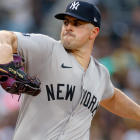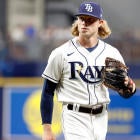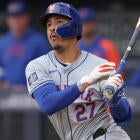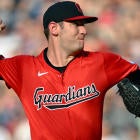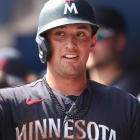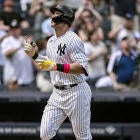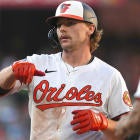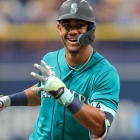Want to get a jump on the competition? Go to the CBS Sports app on your phone, open up "Settings" and sign up for Fantasy alerts to get the latest from our Fantasy baseball team as soon as it's available.
The starting pitcher position has taken its lumps over the past couple years.
Sweeping changes across the game, from usage limits to a homogeneity of skills, reduced the position to mostly matchup plays, with basically just a couple dozen standouts calling the shots.
It made for a desperate environment wherein the risk/reward computation tilted heavily toward the latter. The best, most dominant pitchers were also the only ones handling an ace workload. With quality and quantity both going to the same place, the gap between the haves and have-nots became wider than ever.
But last year, we saw a few more instances of what had been lacking: pitchers who could handle an ace workload with numbers good enough to believe, but not so good they were aces themselves. Guys like Jameson Taillon, Miles MIkolas, Zack Wheeler and Jose Berrios -- they're the middle class the position has been missing and what it needs to restore balance to the draft.
Because, let's face it: Hitters are becoming harder to differentiate as well, what with everybody who's anybody capable of knocking 20 homers these days. The true standouts are all basically gone within the first two rounds, leaving you to debate Anthony Rendon or Eugenio Suarez a good four rounds later. Like with the middle class at starting pitcher, you don't know what's worth paying up for.
What a luxury to be able to pass up pitchers early again.
That's not to say a stud pitcher isn't among the the most impactful players you could draft, just that you won't feel so hopeless if you wind up with two instead of three — or maybe just one, if your offense legitimately stands out from the others. (Granted, that's harder to ensure in an era when positions of similar depth are stocked with hitters of similar impact, but well, now I'm repeating myself).
Max Scherzer is the undisputed No. 1 at the position, his combination of dominance and durability is unmatched these days, and he'll probably be the only one drafted in Round 1, perhaps as early as fifth overall. Chris Sale has a similar track record but is coming off a year plagued by shoulder issues and has an annoying tendency to wear down in the second half. Jacob deGrom, Corey Kluber, Justin Verlander have all shown they can keep up in terms of performance and innings, and those five form a Super Elite tier at the top of the position.
Next comes newcomer aces like Blake Snell, Aaron Nola, Trevor Bauer, Gerrit Cole and Patrick Corbin, who may be capable of matching the Super Elite in effectiveness but probably not in workload. They join holdovers like Noah Syndergaard, Carlos Carrasco and Zack Greinke, who similarly come up short.
Then there's Walker Buehler and German Marquez, who for at least half of last year proved capable of hanging with the aces. Also James Paxton and Stephen Strasburg, who could also hang if they could just stay healthy.
That's three distinct tiers, and we're still not to the middle class — Taillon, Berrios, etc. — yet.
We're also only in about Round 6 or 7 of a standard 12-team draft, making it pretty easy to secure three of the pitchers from those three tiers if you see fit — and that's even if you decide to take a hitter with each of your first two picks.
Now, there does come a point when it's not so clear what you're paying for anymore, but that's after we've passed more ordinary innings eaters like Cole Hamels and Rick Porcello, upside targets like Luis Castillo and Jon Gray and bounce-back candidates like Yu Darvish and Robbie Ray.
See there? We're up to five distinct tiers of pitchers you might actually, legitimately want to own, which suggests a more refined pitching pool than the haves and have-nots of the past couple years. Again, it doesn't mean you can expect an ace to emerge from the non-aces like in the good old days -- innings increases are no longer so predictable -- but it does mean there's more to be had out there than just matchup plays.
Scott's starting pitcher to buy:
Nick Pivetta. The guy had one of the best K-to-BB rates in all of baseball last year but was ruined by horrible defense and plain, dumb luck, both of which should be corrected in 2019.
Scott's starting pitcher to sell:
Madison Bumgarner. The velocity, swinging strike rate and strikeout rate are all trending the wrong way and fast, suggesting his effectiveness is hanging by a thread.
So which Fantasy Baseball sleepers should you snatch in your draft? And which undervalued pitchers can help you win a championship? Visit SportsLine now to get Fantasy Baseball rankings for every single position, all from the model that called Scooter Gennett's huge breakout last season, and find out.













